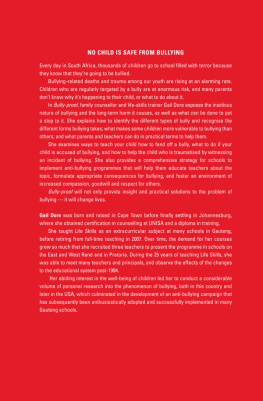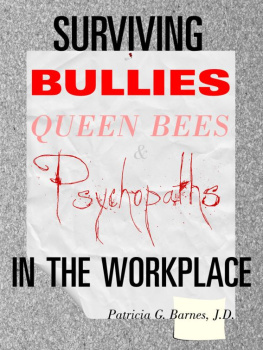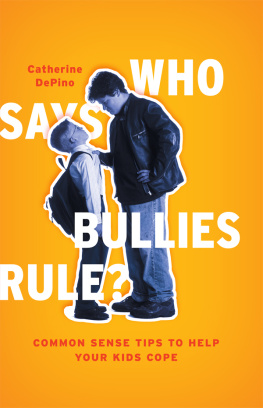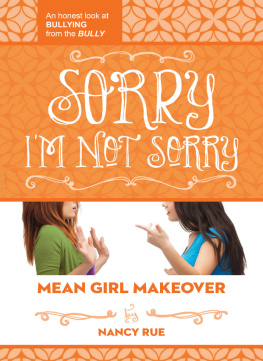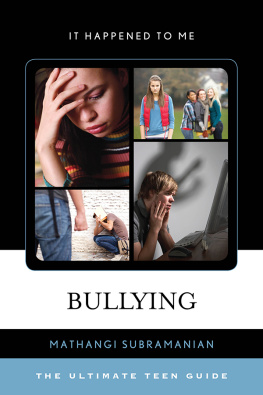of related interest
Bully Blocking
Six Secrets to Help Children Deal with Teasing and Bullying
Revised Edition
Evelyn M. Field
ISBN 978 1 84310 554 1
eISBN 978 1 84642 632 2
Asperger Syndrome and Bullying
Strategies and Solutions
Nick Dubin
Foreword by Michael John Carley
ISBN 978 1 84310 846 7
eISBN 978 1 84642 635 3
Being Bullied
Strategies and Solutions for People with Aspergers Syndrome
Nick Dubin
DVD
ISBN 978 1 84310 843 6
eISBN 978 1 84642 538 7
Working with Anger and Young People
Nick Luxmoore
ISBN 978 1 84310 466 7
eISBN 978 1 84642 538 7
Listening to Young People in School, Youth Work and Counselling
Nick Luxmoore
ISBN 978 1 85302 909 7
eISBN 978 1 84642 201 0
Understanding School Refusal
A Handbook for Professionals in Education, Health and Social Care
M. S. Thambirajah, Karen J. Grandison and Louise De-Hayes
ISBN 978 1 84310 567 1
eISBN 978 1 84642 747 3
New Perspectives on Bullying
Ken Rigby
ISBN 978 1 85302 872 4
eISBN 978 1 84642 323 9
THE
BULLIES
UNDERSTANDING BULLIES AND BULLYING
DENNIS LINES
Jessica Kingsley Publishers
London and Philadelphia
First published in 2008
by Jessica Kingsley Publishers
73 Collier Street
London N1 9BE, UK
and
400 Market Street, Suite 400
Philadelphia, PA 19106, USA
www.jkp.com
Copyright Dennis Lines 2008
All rights reserved. No part of this publication may be reproduced in any material form (including photocopying or storing it in any medium by electronic means and whether or not transiently or incidentally to some other use of this publication) without the written permission of the copyright owner except in accordance with the provisions of the Copyright, Designs and Patents Act 1988 or under the terms of a licence issued by the Copyright Licensing Agency Ltd, Saffron House, 610 Kirby Street, London EC1N 8TS. Applications for the copyright owners written permission to reproduce any part of this publication should be addressed to the publisher.
Warning: The doing of an unauthorised act in relation to a copyright work may result in both a civil claim for damages and criminal prosecution.
Library of Congress Cataloging in Publication Data
Lines, Dennis.
The bullies : understanding bullies and bullying / Dennis Lines.
p. cm.
Includes bibliographical references and index.
ISBN-13: 978-1-84310-578-7 (pb : alk. paper) 1. Bullying. I. Title.
BF637.B85L56 2008
302.3--dc22
2007031850
British Library Cataloguing in Publication Data
A CIP catalogue record for this book is available from the British Library
ISBN 978 1 84310 578 7
eISBN 978 1 84642 752 7
Contents
Preface
The theme for this book emerged from my therapy work with young people in secondary school. In listening to the stories of teenagers facing parental separation and family conflict, there appeared new narratives of their parents own struggles in managing life and their own relationship battles voiced through them. After I invited the parents to come into school, I found they were keen to offload their own anxieties about their past, present and future. Therapy with parents over their offsprings management therefore reinforced for me the almost inescapable cyclic nature of family difficulties.
A second factor was a rising concern over child protection. For some years I had served my school as the designated teacher for child protection and children in public care, and over that period there were trends in policy change and practice that I felt uncomfortable with. One was an over-the-top reaction to parental over-correction when tempers were raised with adolescents over their challenging behaviour. I had witnessed young teenagers or their parent or step-parent removed from the family home in order to secure protection from an abusing adult, when what was wanted was the behaviour to stop, not a person removed. Although I recognize the difficulty in managing child protection in a media-hungry, holier-than-thou age, it appeared to be a back-covering exercise of social workers to avoid culpability. What I felt some families needed was support and guidance, not prosecution. And whenever I saw child protection inquiries being completed with no charges brought against the perpetrator and the authorities swiftly moving out and closing the file, I thought more understanding was required, not more legislation.
Acknowledgements
I thank all the headteachers I have served under and particularly my current headteacher, Dave Firman for their support over the years in recognizing the therapeutic needs of pupils at a time when education has become so competitive and where resources are so stretched to reach academic targets. I thank also my young clients and their parents for allowing me to enter their private worlds of trouble and despair. I am particularly grateful to three major contributors to this book for granting me permission to tell their stories, albeit anonymously, and many more who have shared their insights and experiences. Finally, I express gratitude to my friend Wendy Oldfield-Austin for inspiration to begin this book.
I am grateful to Jean Barley and Steve Fitton for their artwork, and to The M. C. Escher Company for granting permission to use Eschers Relativity. Throughout the book the text is illustrated with photographs of typical bullying situations. I am grateful to my peer counsellors and their parents for allowing me to publish these pictures. I have to stress that these were not real situations but were simulated events that the students put together. I also have to say that although this book covers school bullying, all the evidence routinely collected has given me an assurance that bullying is a minimal problem in the school where I counsel, thanks to a vigilant management team led by a headteacher who places the need for an ethos of anti-bullying high on the school agenda. Finally, I am grateful to Stephen Jones, commissioning editor at Jessica Kingsley Publishers, for advice in steering this book through to completion.
Introduction
A pupil at school told me of his 15-year-old friend who punched himself hard in the face and head-butted the bus shelter simply because he had missed the last bus home that would have prevented him from getting a beating from his dad.
I once counselled a 13-year-old girl whose grandmother told her that as a babe in arms she was held over a balcony and threatened to be dropped during a domestic quarrel between parents. I have wondered over the years how such a negative view of self embedded in the mind might affect relations with others.
Bullying behaviour occurs in many areas of social life, including school, the family and the workplace. There are many group contexts where some individuals seek to exercise domination and control over weaker people, and the reasons for this are not as clear as is often supposed. Rules and procedures to curb school bullying, domestic violence and institutional bullying are so obviously in tune with Western democratic values that they hardly need justifying. But a paradox exists in many cultures in that, whereas political and humanitarian values decry bullying behaviour, legislation and civil rights manifestos do not of themselves reduce the possibility of bullying in the home, the school or the workplace. Whilst behaviour may be modified to some extent by legal codes, morality is another matter.



